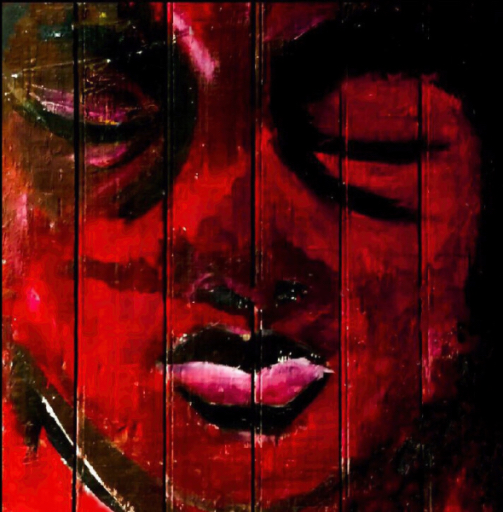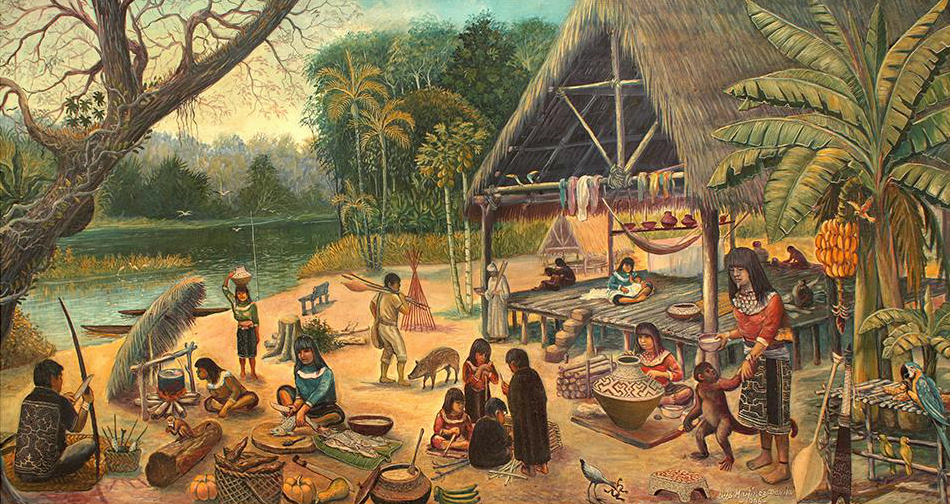
Luis Dávila Martínez, Contemporary Amazonian art – A moment of Shipibo life in nature and tradition.
Art from the Amazon—
between tradition and transformation
Amazonian Artistic Expressions,
Origins, Identity, and Cultural Diversity
Magic, mysticism, and fascination are often associated with the legendary world of the Amazon rainforest. But behind these notions lies a reality that is far more complex, contradictory, and, at the same time, even more awe-inspiring.
To truly grasp the essence of Amazonian Art, we must explore a world as dynamic, diverse, and profound as the rainforest itself. In this world, Amazonian artistic expression unfolds along two distinct yet interconnected paths:
Contemporary Indigenous Art, created by artists belonging to Indigenous communities, whose work is grounded in ancestral knowledge, collective memory, and spiritual worldviews; and
Contemporary Amazonian Art
is developed by artists from diverse cultural backgrounds who, although not Indigenous, share a profound connection to the Amazon through lived experience, regional belonging, and artistic engagement.
Both artistic traditions share the same geographic origin—the vast Amazon Basin, an ecosystem that profoundly shapes the lives of its inhabitants. Yet, they arise from different cultural imperatives and artistic approaches.
This text is dedicated to these two main currents, exploring their distinct characteristics, motivations, and modes of expression, and showing how the art of this region can expand our understanding of identity, creativity, and cultural survival.
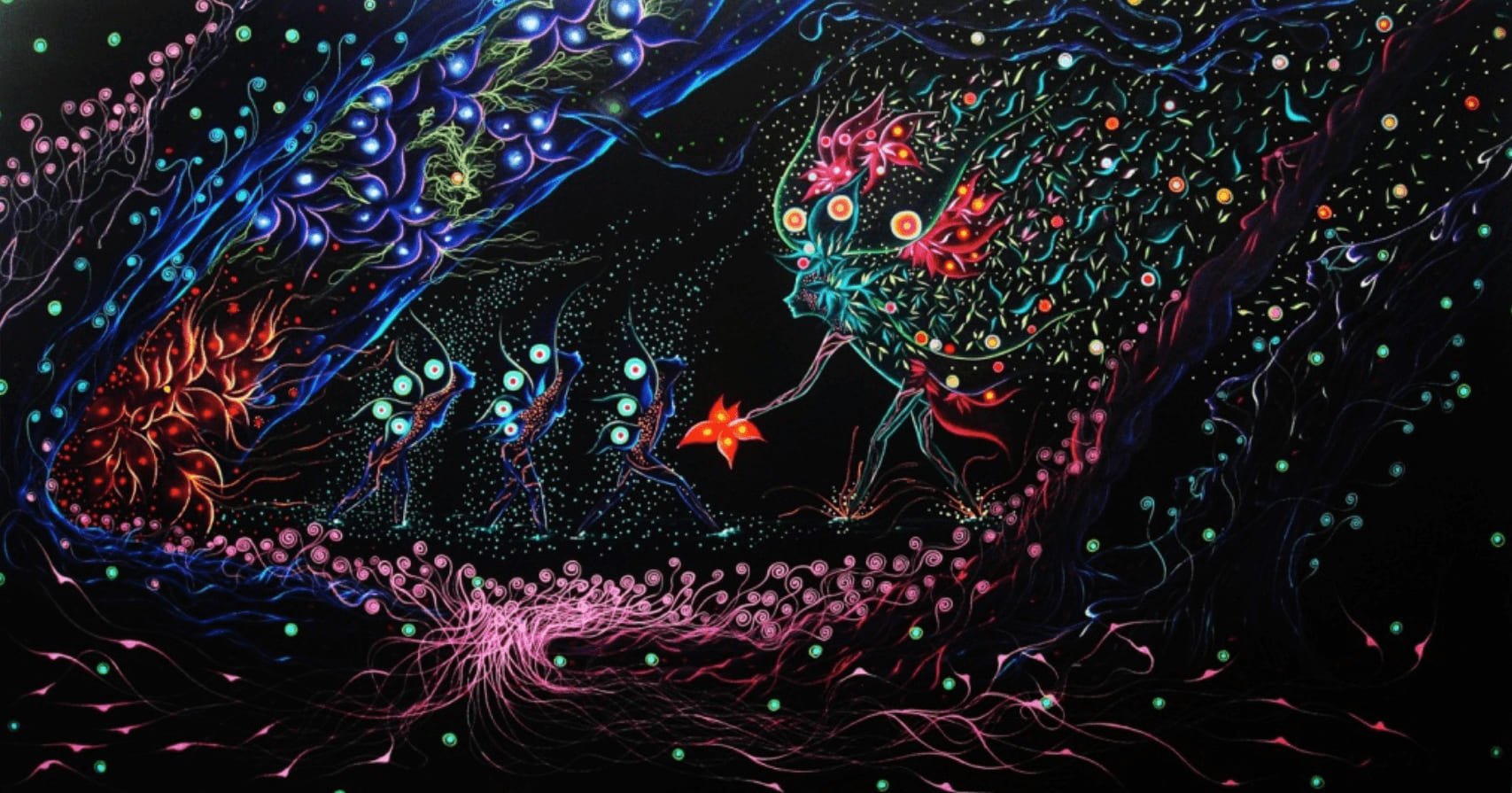
Rember Yahuarcani, Contemporary Indigenous art inspired by memory, myth, and ancestral presence.
Contemporary Indigenous Art—
Cosmovision, Identity, and Cultural Survival
Between Legacy and Renewal –
Carried by the Wisdom of the Ancestors
Amazonian Indigenous art, which bridges ancestral memory and contemporary expression, has multiple origins and faces. It reaches back thousands of years—beyond all written transmission—yet it continues to live in the present: renewed, powerful, alive.
Some of its traces can be followed back to ancient rock paintings; others are born today on canvas or paper, sustained by the same spiritual connection to the world.
Traditional art is often a collective expression—a knowledge shared, passed down, and preserved across generations. And yet, there are artists whose individual voices open new paths and expand the understanding of Indigenous art beyond its origins.
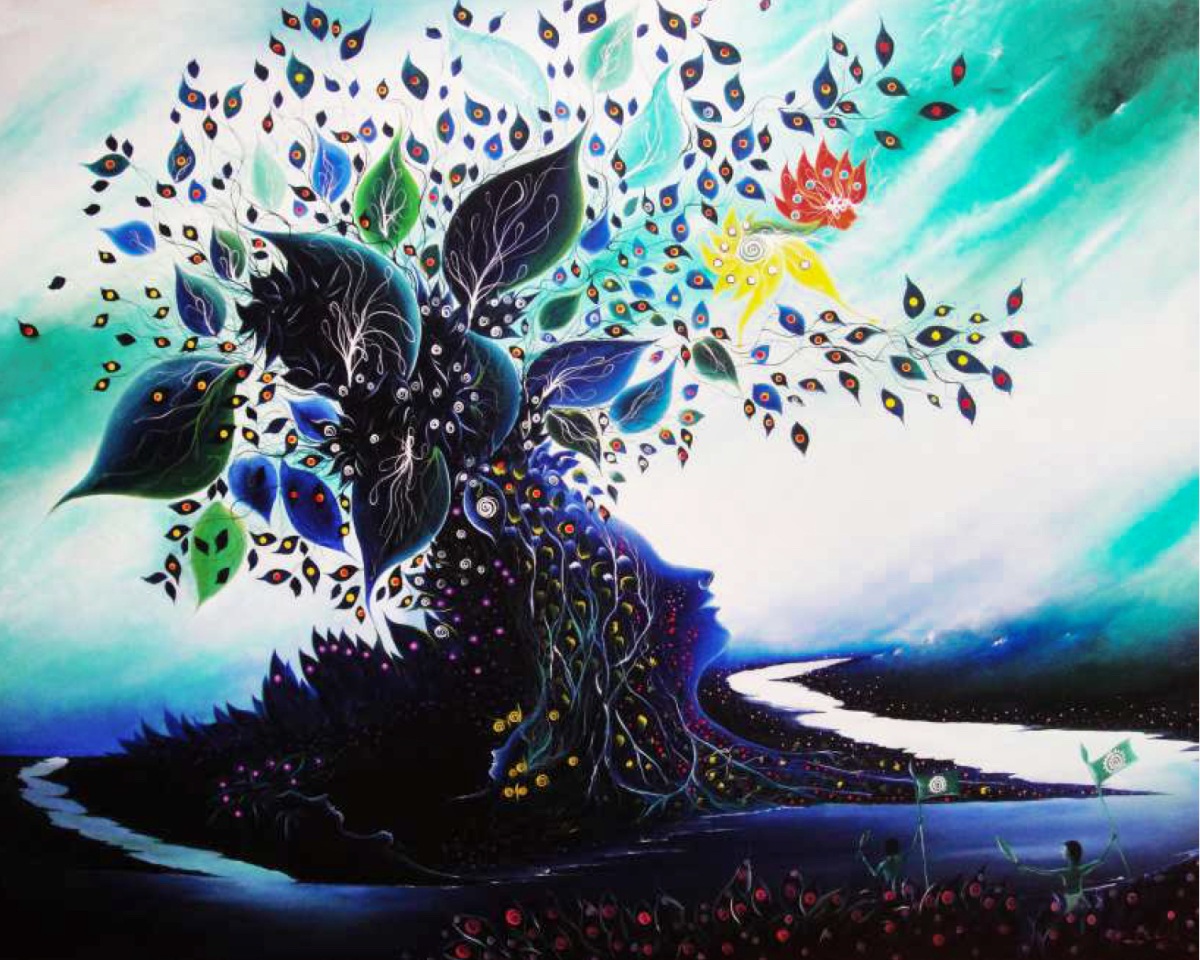
Rember Yahuarcani, La Isla, Contemporary Indigenous Art
Víctor Churay Roque – Ivá Wajyamu
A pioneer of contemporary Indigenous art and a key artist of the Huitoto people
“I don’t paint what I see, but what I feel. What comes to me in dreams or what the ancestors show me. The images don’t come from me – they come through me.”
Víctor Churay Roque, known as Ivá Wajyamu (“the one who comes with the word”), was a prominent Indigenous artist of the Huitoto people who gained international recognition in the 1990s through his painting. He is often regarded as a pioneer of a new generation of Indigenous artists who have united an ancestral worldview with contemporary forms of expression.
His artistic inspiration stemmed from the knowledge of his ancestors, which was primarily transmitted to him by his maternal grandfather, a Huitoto wise man and guardian of traditional knowledge. This familial access to mythology, rituals, and spiritually significant plants directly nourished Víctor’s visual universe. His paintings depict visionary scenes where cosmological concepts, spiritual beings, healing plants, and soul journeys interweave.
Ivá Wajyamu was the first Indigenous artist to exhibit his work not only in local contexts but also internationally—in cities like Bogotá, Paris, and Havana. In doing so, he opened the path for many others. He demonstrated that Indigenous art is not only to be preserved but also capable of evolving and acting as a critical voice in the present.
His work was not a mere illustration of ancestral myths, but a living worldview made visible—an artistic response to colonial trauma, environmental threats, and questions of identity. In an interview, he once said his art was a way to “turn his inner self outward”: for him, painting was a form of healing and a cultural affirmation of existence.
Ivá Wajyamu passed away in 2002 under tragic circumstances, but left behind a remarkable artistic legacy that remains deeply relevant to this day.
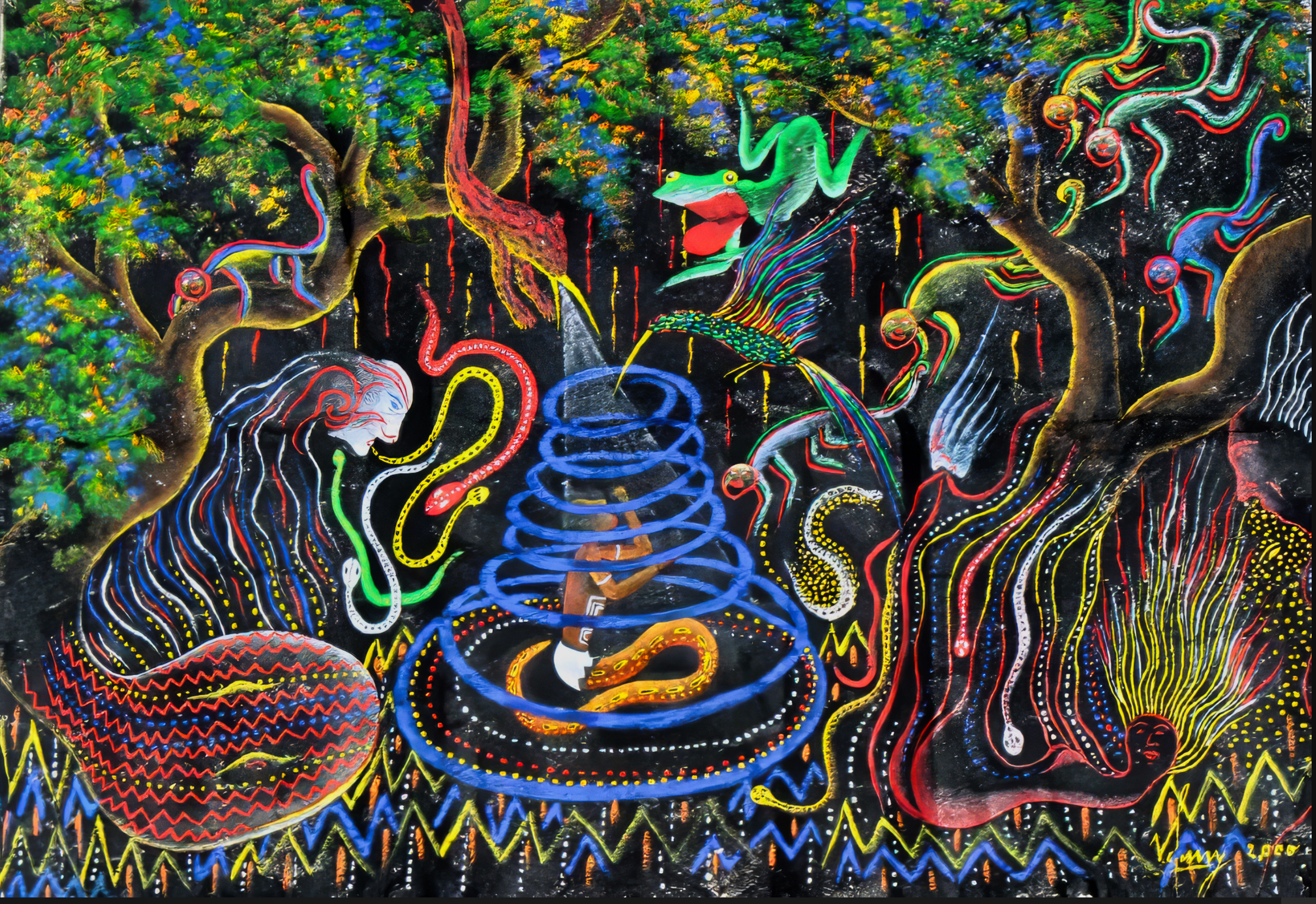
Victor Curay Roque, Visiones
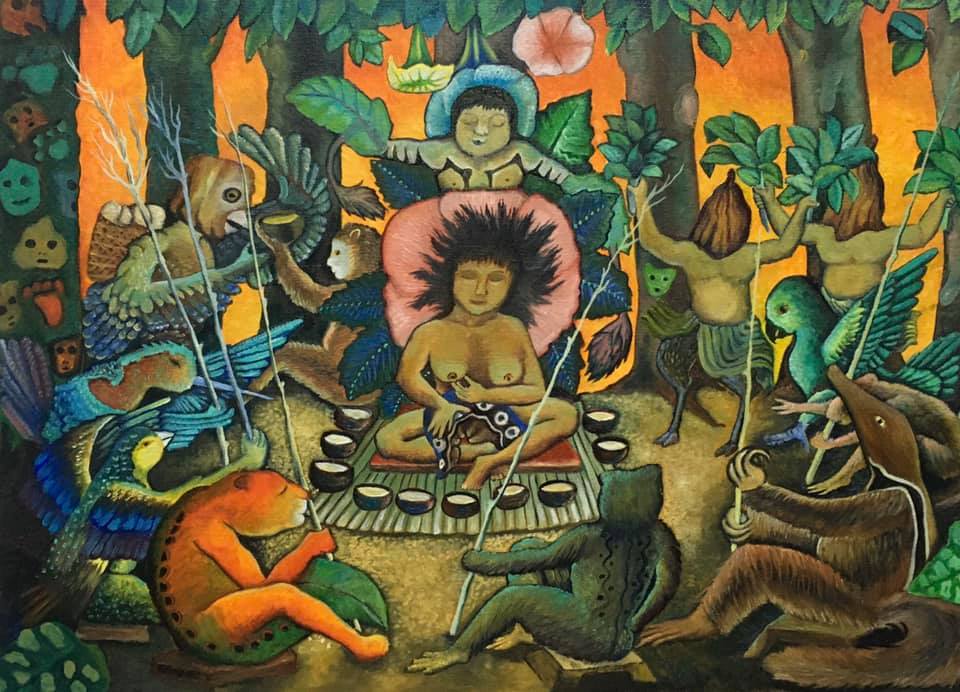
Brus Rubio, Bie isoi comuide
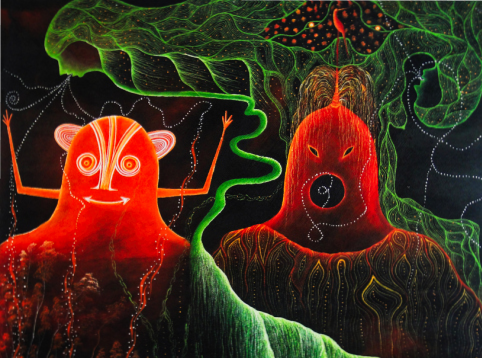
Santiago Yahuarcani, Triunfo
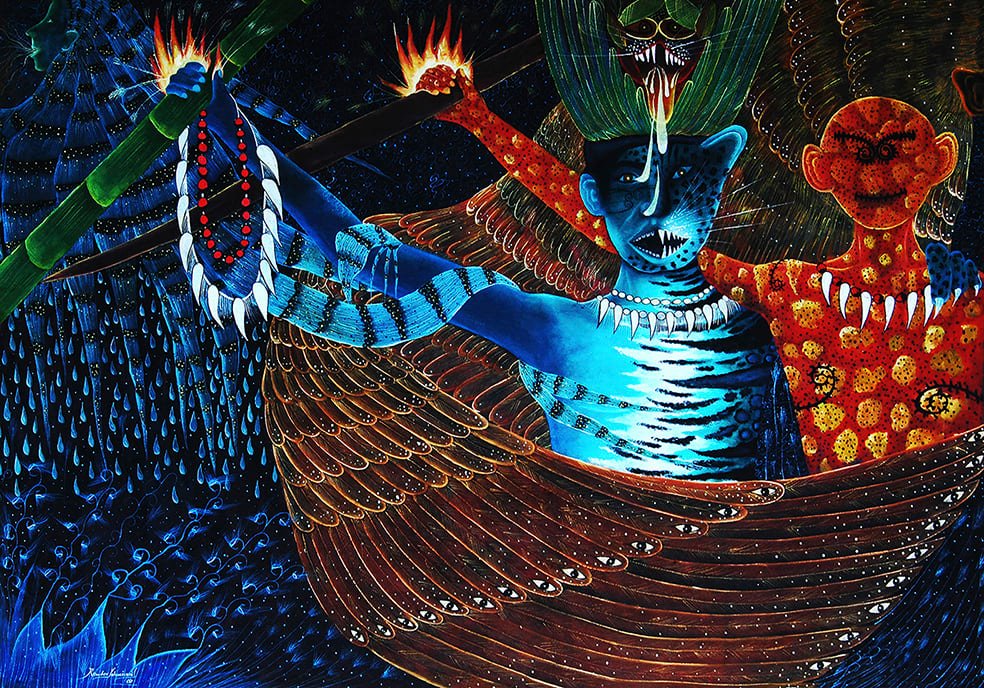
Rember Yahuarcani, S/T
The Power of Indigenous Art—
Healing, Remembering, Transforming.
While contemporary Indigenous art encompasses a diverse range of voices, a few artists stand out as key figures shaping its form and impact: Víctor Churay’s pioneering vision, Santiago Yahuarcani’s ancestral depth, Rember Yahuarcani’s spiritual universe, and Brus Rubio’s vivid, mythical storytelling.
Their work extends beyond aesthetics, serving as a powerful vessel for healing, the continuity of spiritual traditions, and the preservation of collective memory, especially in light of the trauma caused by the rubber boom and the near-collapse of Indigenous societies.
With unique approaches and rich imagery, these artists continue to influence the contemporary Indigenous art movement, which is both rooted in tradition and radically modern.
Guardians of the Amazon – Indigenous Artists and Their Legacy
Resistance, Cultural Continuity, and Spiritual Depth
Contemporary Indigenous painting has become a powerful tool for cultural preservation and political engagement. Faced with relentless pressures from deforestation, resource extraction, and external cultural influences, Indigenous artists use their work to affirm their identity, defend their ancestral lands, and draw international attention to the environmental and human rights crises in the Amazon region.
For thousands of years, the Indigenous peoples of the Amazon have conveyed their worldviews through symbolically rich visual forms. Body painting, ceramics, weaving, feather art, and rock carvings are all essential expressions of spiritual beliefs, historical knowledge, social structure, and a deep connection to the natural world.
Contemporary Indigenous art of the Amazon is not a break from tradition, but a living evolution – a creative translation of ancestral worldviews into new media and contexts. It remains deeply connected to cosmology, mythology, and collectively held knowledge. For many Indigenous artists, art is more than just an aesthetic expression; it is a spiritual practice – sacred, alive, and rooted in community.
It acts as a visual language that reveals their close connection with nature, the spirits of the forest, medicinal plants, and the ancestral wisdom passed down through generations. The artworks display symbolic patterns, colors, and figures whose meanings are deeply rooted in each community’s collective memory.
This art is a visual legacy, a powerful call for justice, and a vivid testimony to enduring resilience.
It contributes to the global Indigenous visual culture and enhances discussions on ecological awareness, cultural self-determination, and artistic resistance.
Themes and Symbolism
A central and ever-present theme is the interconnectedness of all beings within the rainforest ecosystem. Animals are seen not only as living creatures but also often as spiritual entities, ancestors, or shape-shifters. Plants—especially those with medicinal or ceremonial importance—hold deep symbolic meaning.
Mythological stories—such as creation myths, epic journeys, and encounters with otherworldly spirits—are often depicted on the canvas. Geometric patterns frequently appear, such as the kené designs of the Shipibo-Conibo or the detailed ornaments of the Kaxinawá/Huni Kuin, which are believed to carry energetic power or symbolize visions experienced during spiritual ceremonies involving sacred plants like Ayahuasca.
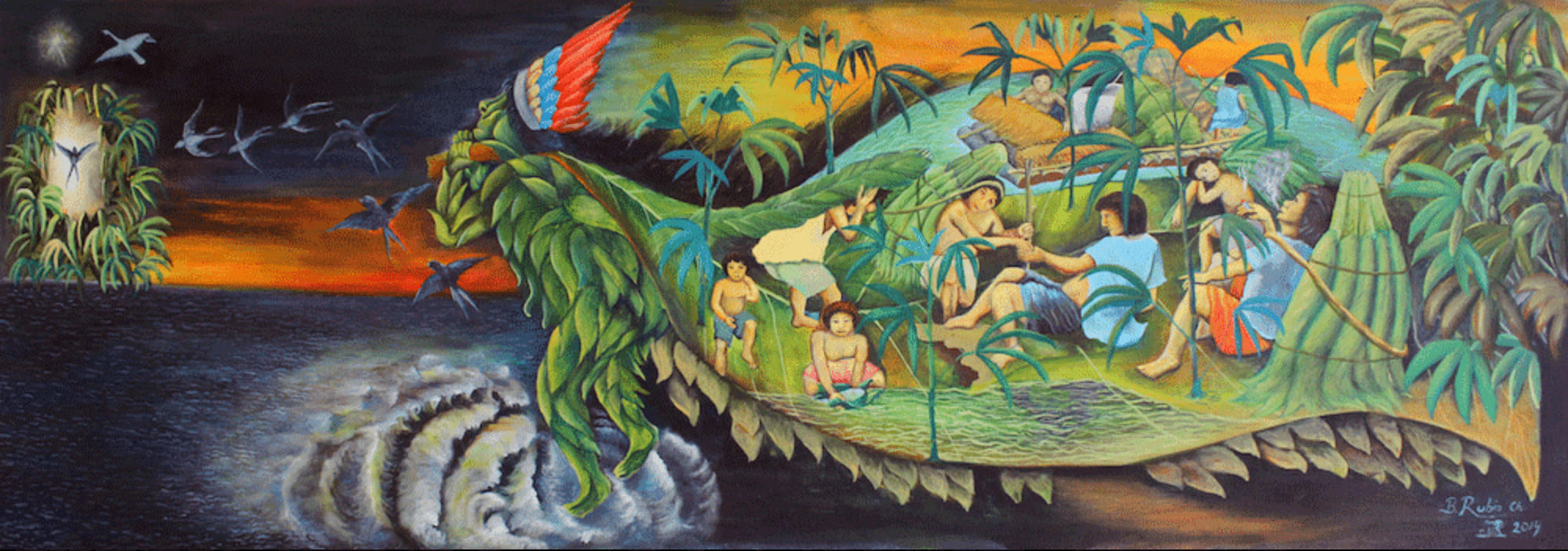
Brus Rubio, El Guia Espiritual, Contemporary Indigenous Art
Materials and Techniques
Indigenous artists originally used natural pigments on bark, wood, or skin. Today, many contemporary painters still use natural dyes, but they are increasingly turning to modern materials like acrylics or oil paints and working on canvas. This shift allows them to create more durable works that can travel across continents and reach new audiences.
Even though the medium is modern, the core visual language stays deeply rooted in tradition. Lines and colors follow a symbolic vocabulary handed down through generations. The brushstrokes might be current, but the stories they tell carry the ancient knowledge of their communities.
Artists from groups such as the Huitoto, Shipibo-Conibo, Asháninka, or Yanomami bring cultural memory to life through their work, giving new relevance to ancient stories with contemporary methods.
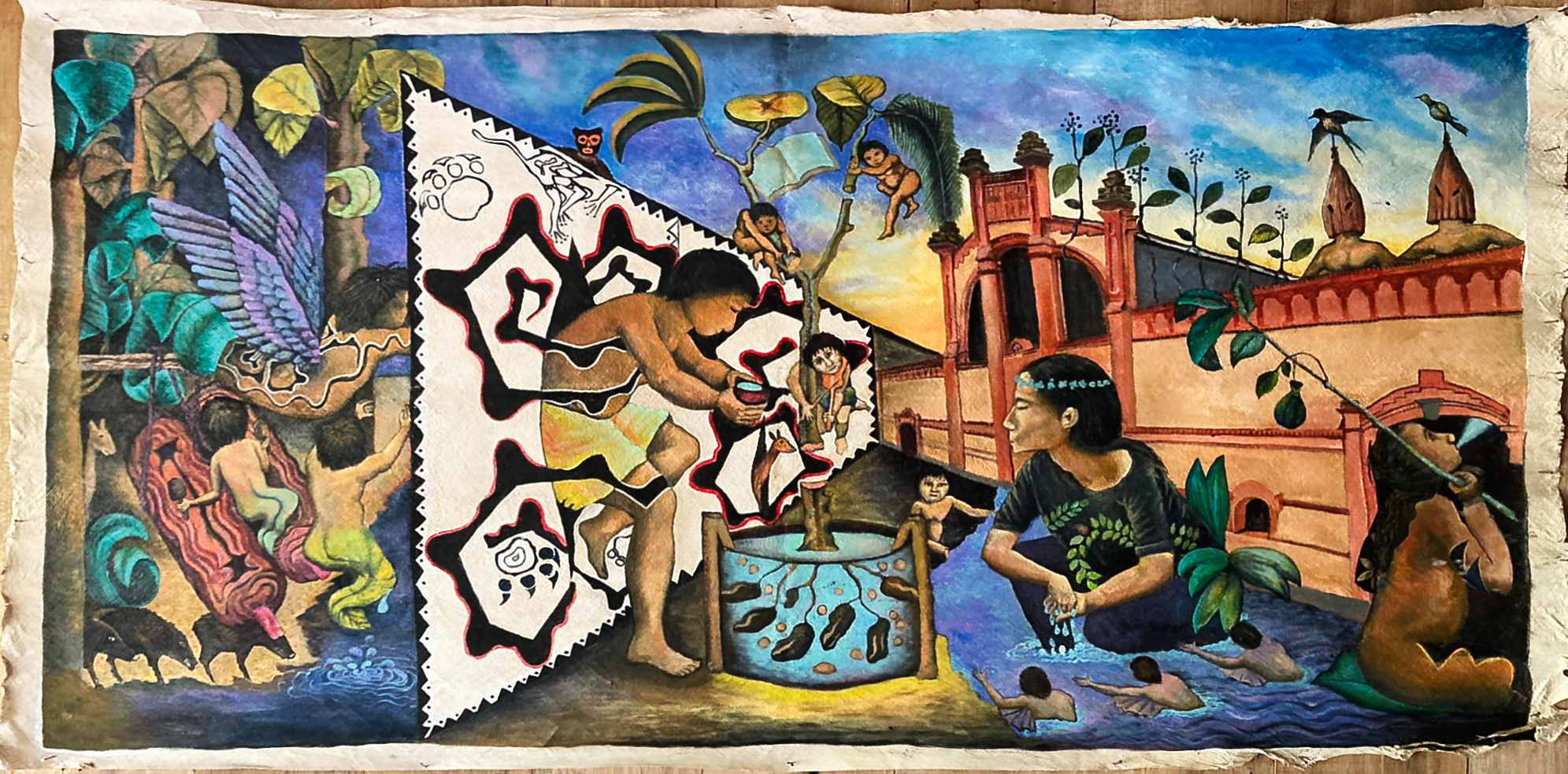
Brus Rubio, Contemporary Indigenous Art
Indigenous Contemporary Art—
Present and Future in the Amazon
Even among Indigenous artists—and I know many personally—there is no single consensus on the core message of their art.
Instead, their works are intricate and multifaceted, powerfully expressing what moves the Indigenous peoples of the Amazon: the loss of their lands, culture, and spirituality, as well as their ancestors’ wisdom and their very identity.
What takes priority varies, depending on who you ask and when.
This lack of consensus and layered diversity is the truth. Contemporary Indigenous art does not present a single message or narrative. Instead, it embodies both wound and healing, loss and reclamation, memory and renewal—spiritual and political, personal and collective.
Each artist’s voice becomes visible in these artworks, expressing personal stories, experiences, and visions while maintaining a continuous engagement with resistance to cultural uprooting and social marginalization, as well as a deep desire for respect, participation, and recognition.
For it is this diversity and tension that make contemporary Indigenous art so powerful, authentic, and relevant.
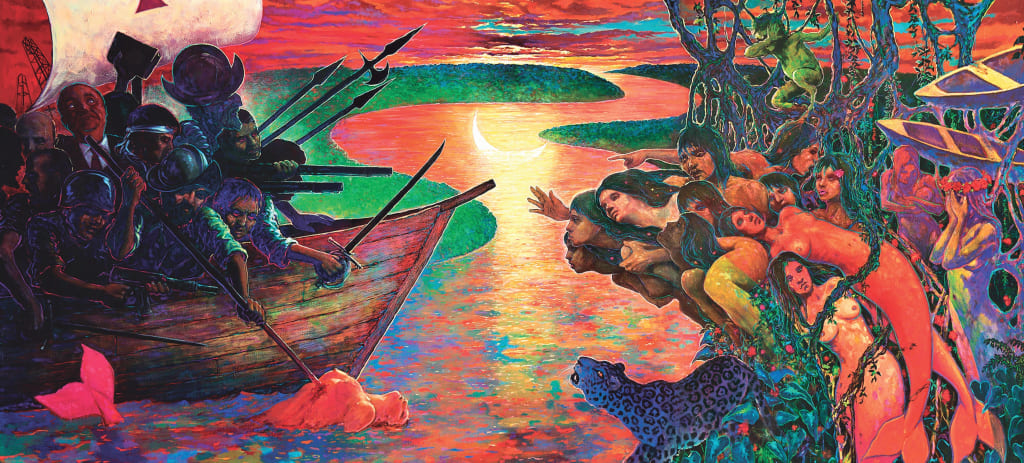
Gino Ceccarelli,”El descubrimento del Amazónas”, Contemporary Amazonian Art
Contemporary Amazonian Art—
Amazonian Voices Beyond Indigenous Origins
Multicultural Amazonian Identity — Shared Origins, Distinct Voices
Contemporary Amazonian art builds on Indigenous painting traditions—closely linked to specific cultural practices and spiritual beliefs—by including a broader and more diverse array of expressions.
It includes works by artists who live in the Amazon region, identify with an Amazonian identity, and, although not of Indigenous descent, draw inspiration from the region’s unique nature, myths, legends, complex social dynamics, and turbulent history. It builds upon Indigenous painting traditions—Situated within the global contemporary art world, these artists, including descendants of European colonizers and people of mixed cultural backgrounds, often adopt its stylistic conventions without losing their connection to the Amazon.
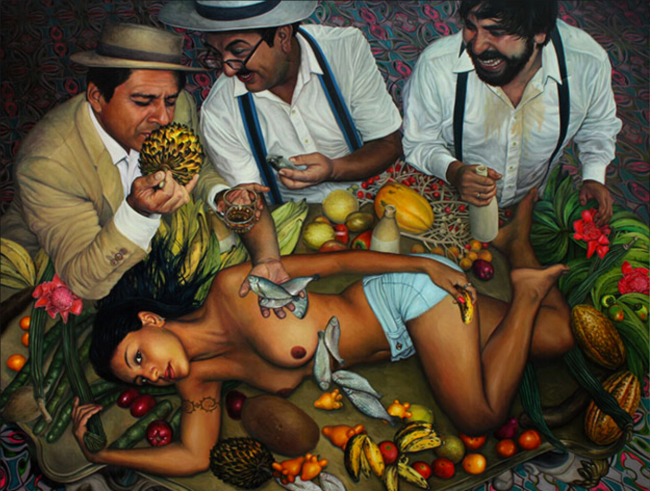
Christian Bendayán,”El Paraiso del Diablo, Arte Amazónica Contemporáneo
Historical Background and Influences
The development of contemporary Amazonian painting is deeply rooted in the region’s colonial history and the shifting fortunes of extractive economies, including the rubber boom, deforestation, oil and gas extraction, and mineral mining. These factors, combined with diverse cultural influences, have significantly shaped this art form.
Early artists often adopted a documentary style, depicting exotic flora and fauna or the daily life of local communities, often from an outsider’s viewpoint. César Calvo de Araújo pioneered this approach, coining the term “Amazonian art” as early as the 1940s. A significant key moment came in 1963 when such a work was first exhibited in a museum.
Over time, artists developed more personal and critical viewpoints influenced by European academic traditions, modern art movements, and the global art scene. Their works shifted from merely external impressions to exploring the myths, legends, and alternative realities that shape life in the Amazon, offering a unique perspective on the region’s complex culture.
Themes and Content – Amazonian Art—
Between Tradition and Intercultural Fusion
Some Amazonian artists are attracted to the vastness and striking beauty of the rainforest, capturing the winding rivers, the lively urban scenes of cities like Iquitos or Pucallpa, and the peaceful rhythms of riverside communities. Their landscapes range from detailed realism to abstract interpretations of the jungle’s wild energy and the constant flow of its waters.
Social realities, however, also come into focus. Many artists directly confront issues such as urbanization, poverty, migration, and environmental degradation, often grounding their work in personal experience. Instead of emphasizing spiritual transformation, they depict the immediate, visible effects of industrial pollution, deforestation, and inequality on local communities.
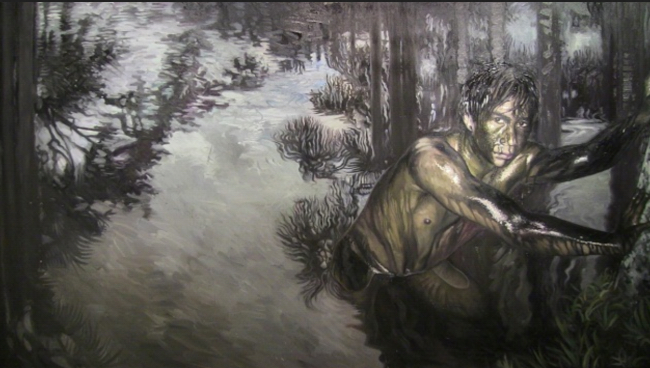
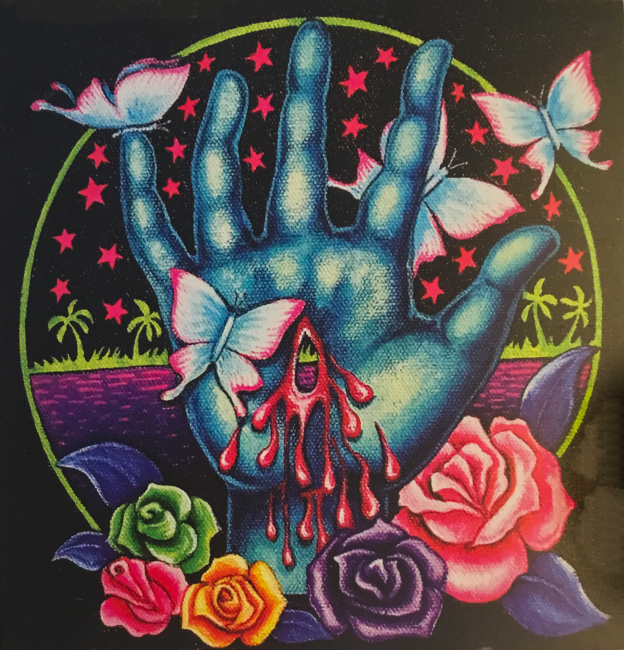
Christian Bendayán, “Hombre en el Rio”, y “Mano de Christo”, Arte Amazónica Contemporáneo
The daily lives of city dwellers, fishermen, rubber tappers, and other local groups provide a rich source of themes and motifs, offering profound insights into the unique social fabric of the Amazon region.
Some artists directly engage with cultural blending, utilizing both Indigenous, European, and modern American influences to illuminate the complex and layered nature of Amazonian society.
Artistic Amazonian Journeys —
Forms and Interpretations in the Amazon
Contemporary Amazonian art is distinguished by its diverse styles and techniques. It reflects the artists’ engagement with a wide array of artistic expressions, from academic realism to expressive and surrealist styles, as well as abstract painting and modern street art.
The natural environment often sparks the initial inspiration for a luminous and intense color palette. However, many artists go further, experimenting with unusual color combinations and exploring formal questions that go beyond simply observing nature.
Unlike Indigenous painting, which is usually deeply connected to the community’s collective knowledge and spiritual traditions, Amazonian art tends to emphasize individual expression and a personal interpretation of reality.
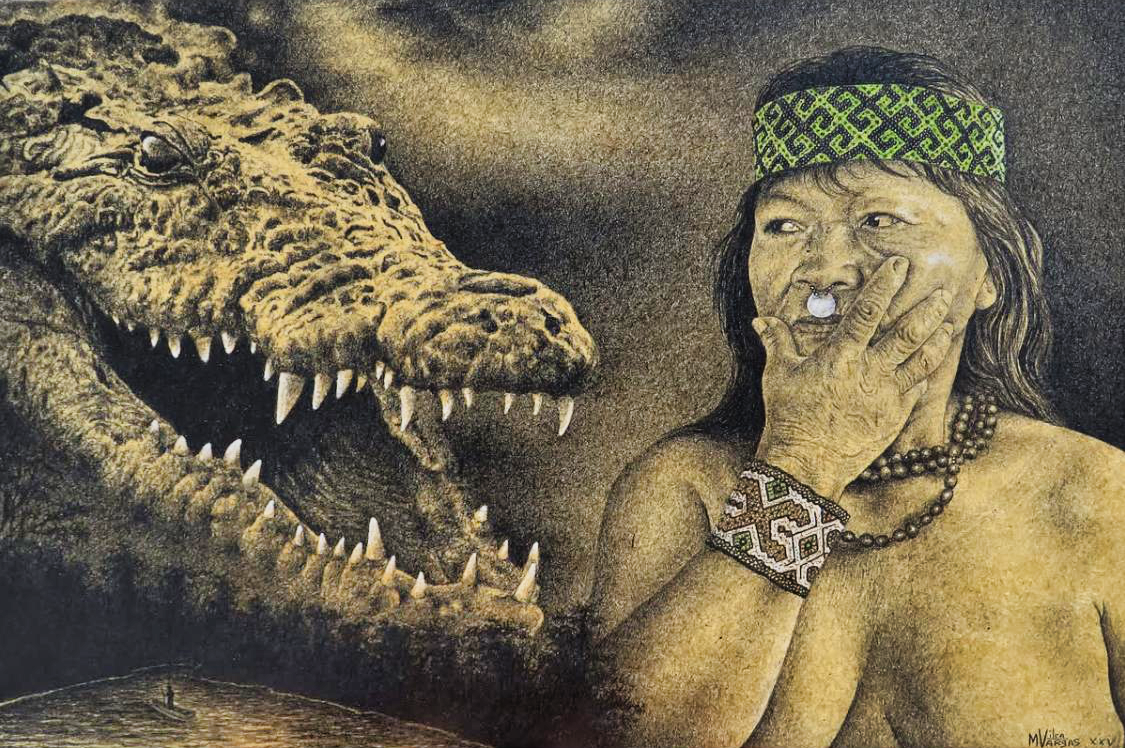
Miguel Vilca Vargas, “Mibe”, Arte Amazónica Contemporáneo
Connections, Differences, and the Shared Identity of Amazonian Art
The motivations and origins of these two currents in Amazonian painting may differ significantly, yet they do not exist in isolation. Instead, they are united by a shared geography and a constantly shifting cultural landscape, even as social divisions continue. Amazonian art, in particular, provides a space where individual expression can go beyond the boundaries of origin and race, enabling a shared Amazonian sensibility to emerge — an authentic voice that resonates beyond the complexities of identity.
However, we cannot overlook that Amazonian artists from diverse backgrounds — who are not part of Indigenous communities — naturally carry their own historical and cultural frameworks. Their work also connects with other cosmogonies, which are alternative ways of understanding the world and the deeper questions of existence. They cannot — nor should they — abandon their academic training, technical skills, or the rational structures behind their compositions, even when they explore the symbolic and mystical.
Even what emerges from our most profound experiences—from the hidden depths within us—is filtered through the lens of both individual and collective experience.
It is in this tension, in the dialogue between ancestral Indigenous tradition and contemporary perspectives, that the richness and complexity of present-day Amazonian come to light.
Amazonian art offers a dual path toward a deeper understanding of the Amazon — and of ourselves.
Shared Foundations
The most obvious connection is the Amazon region itself. The rainforest, with its sprawling river systems, overwhelming biodiversity, powerful presence – and its mysterious world of magic, myths, and legends – is an inexhaustible source of inspiration for both Indigenous and non-Indigenous artists.
Themes such as resilience, survival, and the deep human connection to the land run through both art forms, even when depicted from different perspectives. In their own way, both currents contribute to making a distinctive Amazonian identity visible – an identity that culturally distinguishes this region from other parts of the country.
Two Visions – One Amazonia
Indigenous and Non-Indigenous Art – A Path to Deeper Understanding
Art’s meaning and its potential impact are closely connected to how we understand knowledge: as something we gather, preserve, tell, and pass on. The complex symbolism of modern Indigenous Amazonian art reflects a cosmic worldview (cosmovisión) in which everything is interconnected: what is above in the sky reflects what is below on the earth, and vice versa. Artists see themselves not just as individual creators but as intermediaries between the seen and unseen worlds.
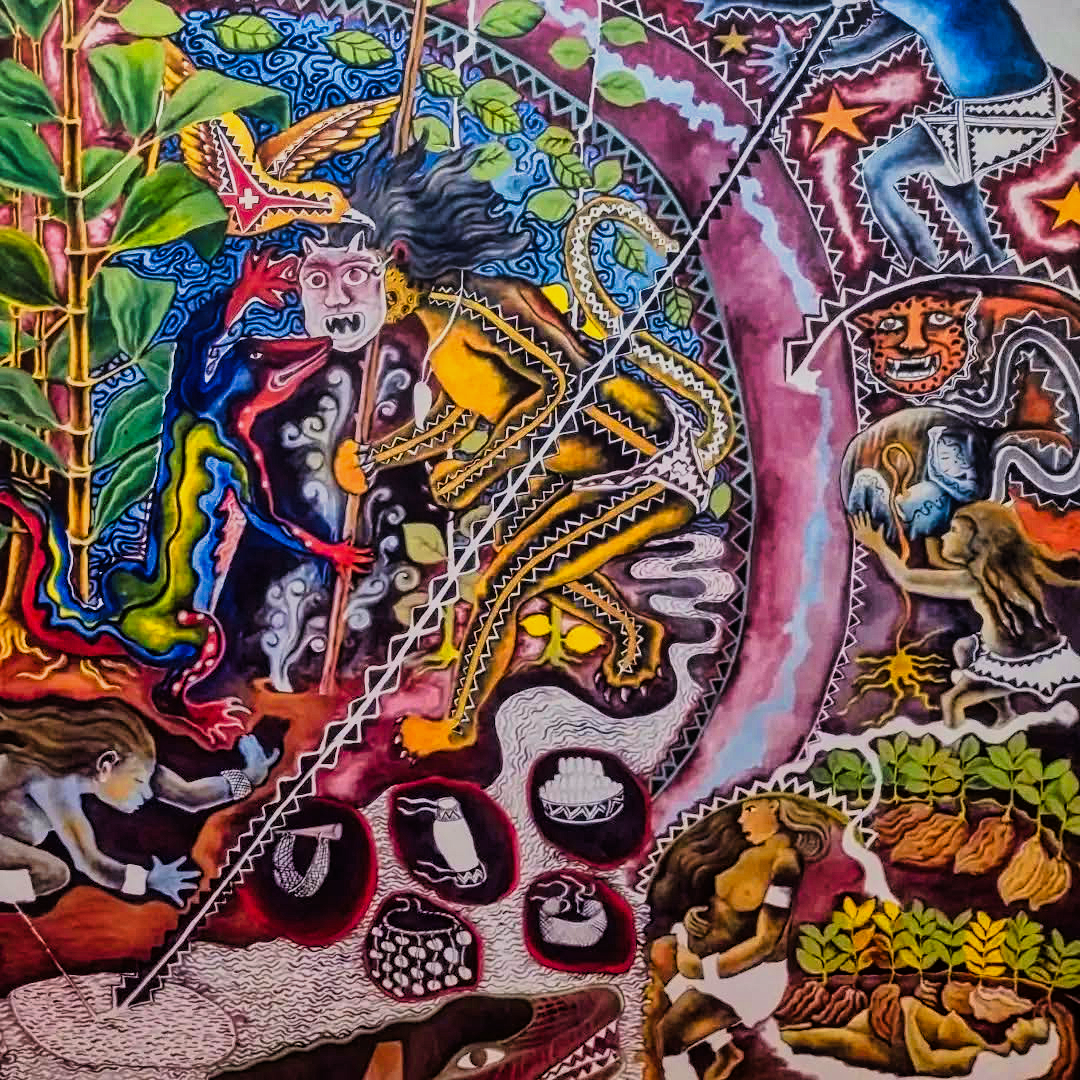
Brus Rubio,”El Laberinto”, Arte indígena Contemporáneo
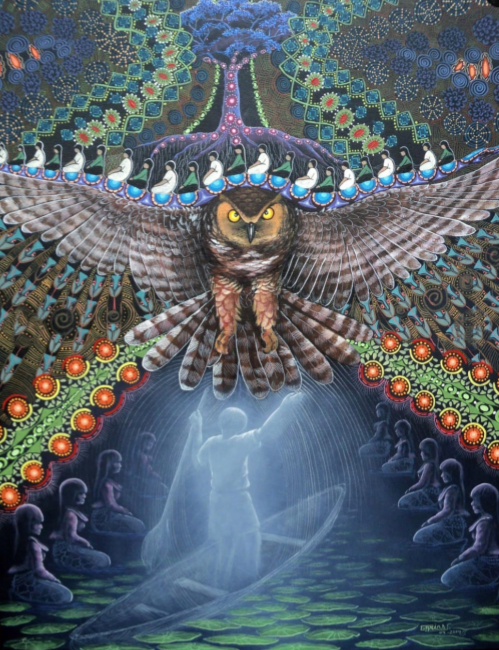
Graciela Arias,”Aguilar”, Arte Amazónico Contemporáneo
The creation of an image or object is not merely an aesthetic act, but a ritual process – a way to make visible spiritual insight, collective memory, and cultural continuity.
Indigenous painting is often a direct expression of spirituality, inherited knowledge, communal survival, and the processing of collective experiences. Its meaning is deeply rooted in a shared understanding of the world.
In many contemporary Amazonian works, spiritual and cosmological dimensions find new expression through artists who rearticulate them within a modern context. Rather than replicating traditional forms, these artists offer powerful interpretations of ancestral knowledge, bringing it to life through personal experience and contemporary aesthetics.
Myths, legends, and inherited narratives are not only reimagined but also serve as visual spaces of collective memory, where history, identity, experience, and worldview are projected and transformed. Through this process, the works emphasize emotional resonance, visual intensity, and individual expression, while remaining deeply rooted in the cultural continuum from which they emerge.
At the same time, a more individual, often introspective expression emerges, making visible exuberance, sensuality, and the joy of life – qualities that are an essential part of the Amazonian feeling for life.
These works celebrate the sensuality of the moment, the richness of human emotions, and the pulsating rhythm of life in the rainforest.
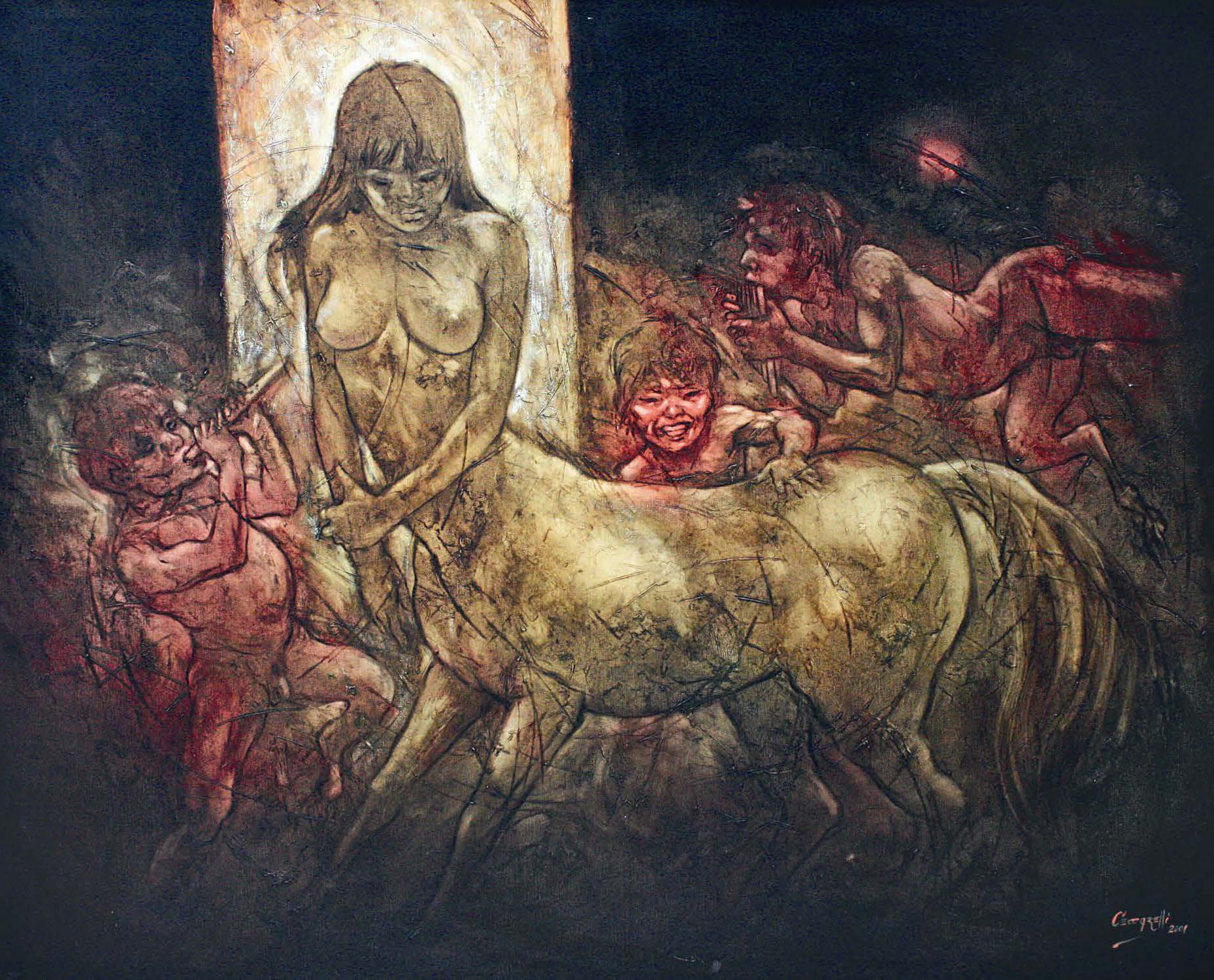
Gino Ceccarelli, “Fantasia”, Arte Amazónico Contemporáneo
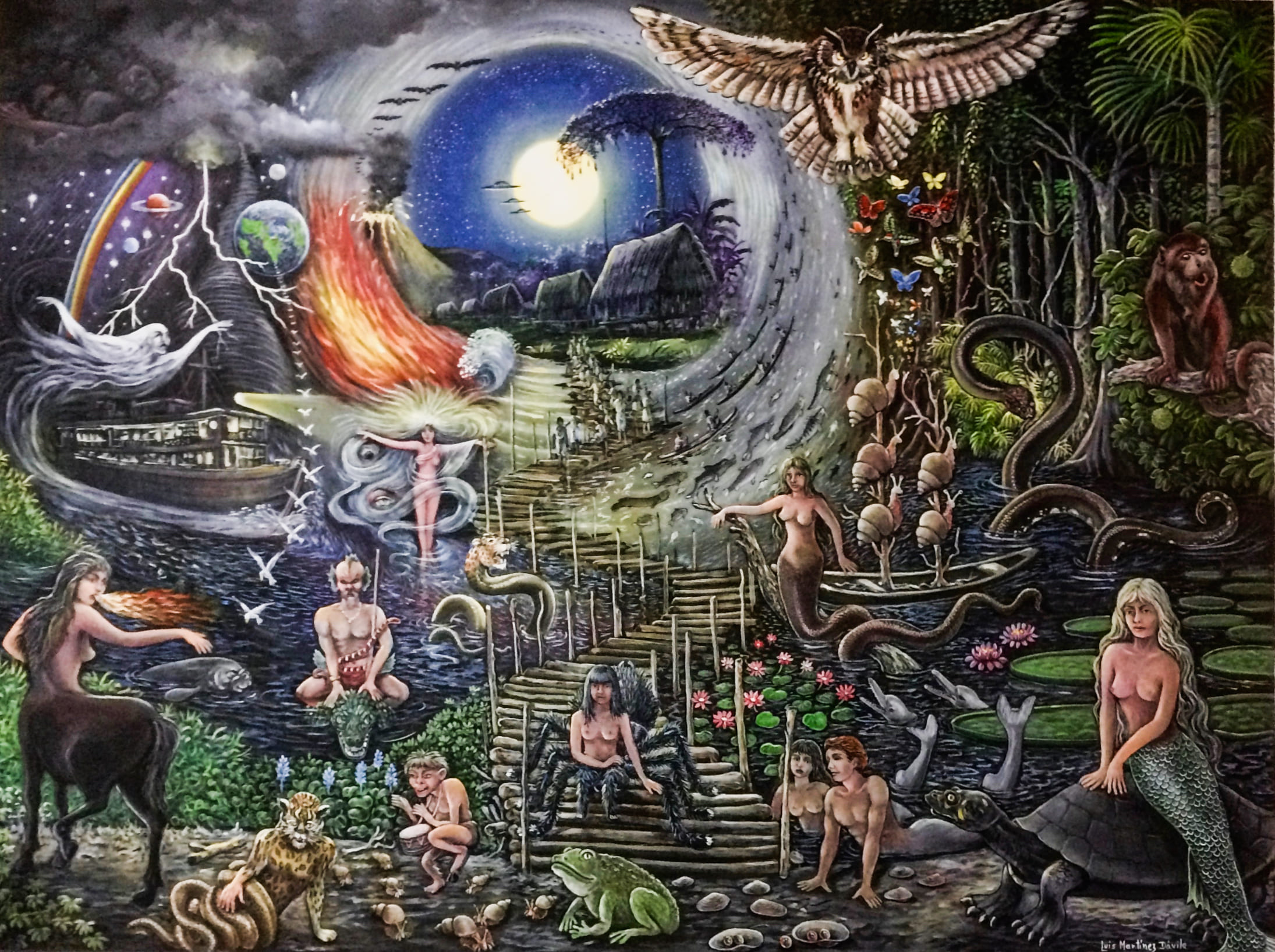
Luis Dávila Martínez,”Vision Amazónica”, Arte Amazónico Contemporáneo
Dialogue and Interaction
A growing dialogue is unfolding between these two artistic currents. Non-Indigenous artists find inspiration in Indigenous patterns, storytelling, or mythologies – an engagement that necessitates respect and sensitivity to avoid cultural appropriation.
Conversely, an increasing number of Indigenous artists are entering the international art community, participating in biennials, exhibits, and debates, and utilizing their work to make themselves visible and wield influence far beyond their communities.
Collaborations remain uncommon, but as they occur, they reveal spaces for reciprocal learning, new standpoints, and a shared creativity that strives not for homogenization but for acknowledgement and appreciation of differences.
Perhaps a new kind of understanding will arise precisely within these interactions—one that does not divide but unites.
Visionary Art
Although it is not the primary focus of this essay, the art movement often referred to as Visionary Art deserves mention. Rooted in the representation of altered states of consciousness, spiritual dimensions, and mystical insights, it shares visual similarities with Amazonian traditions, such as the use of vibrant colors, intricate patterns, and depictions of spiritual beings.
Pablo Amaringo’s works are an outstanding example. They arise from lived experience, deep cultural knowledge, and ceremonial practice and represent a reinterpretation that combines traditional Amazonian elements with influences from modern spiritual and artistic imagery.
However, much of what is marketed worldwide as Visionary Art today reproduces psychedelic imagery that is often disconnected from the cultural and ceremonial context it claims to represent. This frequently results in a commercialized form of mysticism that prioritizes aesthetic appeal over genuine cultural depth, thereby distorting original traditions and diminishing their cultural significance.
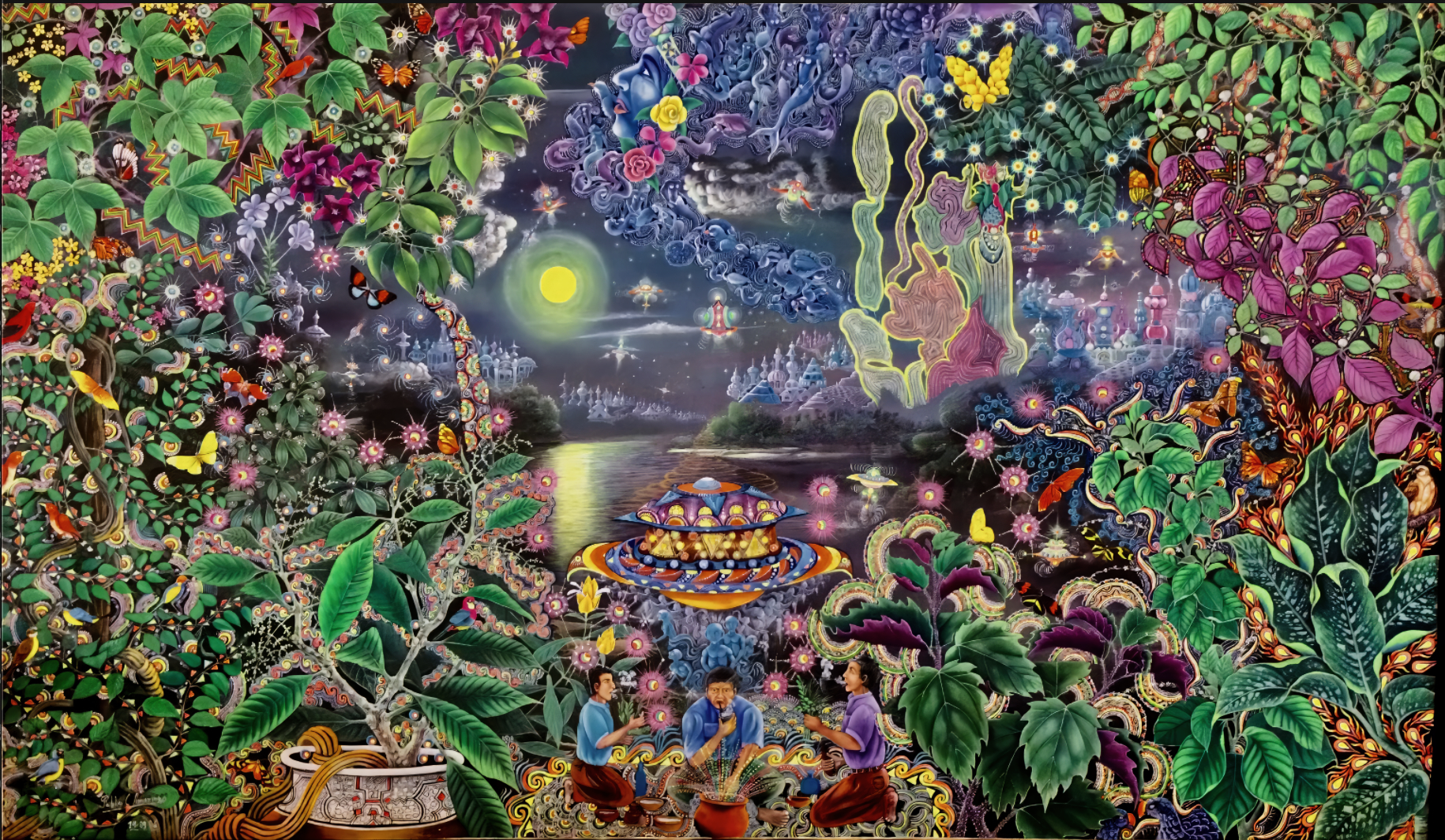
Pablo Amaringo, Visiones, Pablo Amaringo, Visiones, Esta obra nace de una experiencia espiritual guiada por plantas maestras. En ella confluyen símbolos del mundo vegetal, guardianes espirituales, patrones de energía y arquitecturas del universo invisible. Para Amaringo, pintar no era un acto decorativo, sino una forma de preservar y transmitir conocimiento.
The Future of Amazonian Art: Challenges and New Voices
For Indigenous groups, land dispossession, environmental destruction, and cultural marginalization pose a serious threat to the continuity of their traditional ways of life and their cultural identity. Not only is their living environment affected, but so too are cultural continuity and the spiritual basis from which their art arises. At the same time, however, this threat often becomes a source of strong motivation and artistic inspiration.
Despite significant challenges, Amazonian art is increasingly gaining recognition and establishing itself as a distinct, contemporary art form—powerful, dynamic, and ever-evolving.
As global awareness of the Amazon’s ecological and cultural importance grows, so too does interest in its extraordinary artistic expressions. The future promises a sustained flourishing of Indigenous and non-Indigenous voices, each contributing in its unique way to the profound and unfolding narrative of a region that is both deeply primordial and intensely present.
Art does not explain the world – it transforms the lens through which we perceive it.
It safeguards tradition, culture, and remembrance, mirrors the present, and unlocks spaces for insight. It is a realm between worlds, where not only is wisdom imparted, but a profound connection becomes tangible.
Be it ritual or individual, spiritual or social, we encounter stories that are not merely recounted but lived out here.
Amazonian art often reaches us where words can’t—through an invisible thread that connects humans, animals, plants, and spirits. It spans a bridge—invisible yet palpable—like a web of experiences, myths, and dreams that extends beyond the visible horizon.
That bridge leads from the visible realm to the invisible, from the past to the present, from collective remembrance to the individual soul, unlocking spaces where the rational communes with the spiritual, and the material with the transcendent.
Both artistic forms reveal how origin, history, present, identity, and perspective transmute into form and become visible.
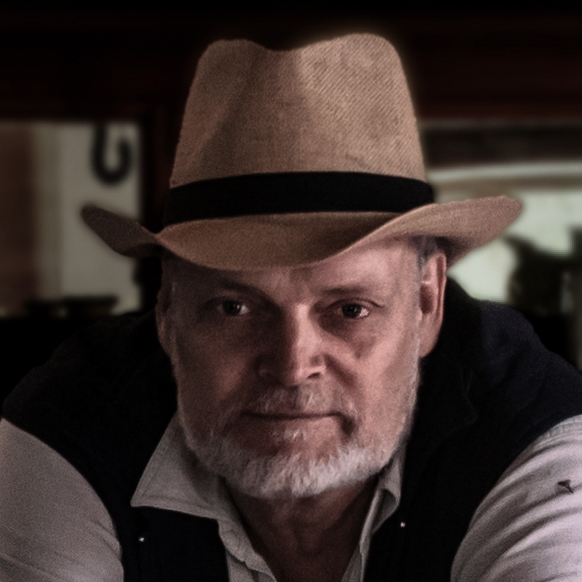
Escrito por Rolf Friberg
